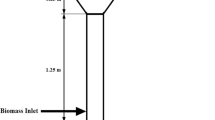Abstract
In the first part of this paper, we introduced a modified rotating biological contactor (RBC) for the biological treatment of waste gas, and demonstrated its feasibility by applying the process to the biodegradation of toluene in a 91-liter reactor containing 20 biofilm support discs with a diameter of 40 cm [1]. We showed that the proposed system allows the unlimited growth of the biofilm to be suppressed, hence eliminating the risk of clogging associated with other biological waste gas treatment systems. Furthermore, we observed stationary long-term performance for more than one year under typical standard operating conditions. In this part of our work, we investigate experimentally the influence of the main process parameters, i.e., gas flow rate, inlet gas concentration, and rotational speed of the biofilm supports on process performance for the same system. Experimental results indicate that the modified RBC system is mass transfer limited for toluene loadings below 150 g/m3h, whereas at higher inlet concentrations of the pollutant, it becomes limited by the biodegradation reaction inside the biofilm. Surprisingly, the disc rotational speed is found to have no major effect on process performance for the system under investigation. A time-independent mathematical model of the process is also presented, and predictions are compared with experimental degradation data. In the range of the investigation process parameters, good agreement between the experimental data and simulation results is obtained.











Similar content being viewed by others
Abbreviations
- C :
-
concentration in the gas phase, g/m3
- D :
-
diffusion coefficient, m2/s
- D eff :
-
effective diffusion coefficient in the biofilm, m2/s
- EC :
-
elimination capacity: amount of substrate degraded per unit reactor volume and time, g/m3h
- f s :
-
biofilm surface enlargement
- J :
-
diffusion flux, g/m2s
- K L :
-
gas–liquid mass transfer coefficient, m/s
- K m :
-
Michaelis–Menten constant, g/m3
- m :
-
gas–liquid distribution coefficient, g/g
- r :
-
radial position, m
- r max :
-
maximum degradation rate, g/m3s
- RE :
-
removal efficiency, %
- S :
-
concentration in the liquid phase and in the biofilm, g/m3
- v :
-
velocity, m/s
- z :
-
position perpendicular to the discs, m
- δ B :
-
thickness of the biofilm, m
- δ G :
-
thickness of the gas phase, m
- δ L :
-
thickness of the liquid film, m
References
Vinage I, Rudolf von Rohr P (2003) Biological waste gas treatment with a modified rotating biological contactor. I. Control of biofilm growth and long-term performance. Bioprocess Biosyst Eng in press
Banerjee G (1997) Hydraulics of bench-scale rotating biological contactor. Water Res 31:2500–2510
Delborghi M, Palazzi E, Parisi F, Ferraiolo G (1985) Influence of process variables on the modeling and design of a rotating biological surface. Water Res 19:573–580
Leduc R, Buchanan I (1993) Minimization of multistage RBC active disc area. J Environ Eng 119:271–286
Hansford GS, Andrews JF, Grieves CG, Carr AD (1978) A steady-state model for the rotating biological disc reactor. Water Res 12:855–868
Vinage I (2002) Biological waste gas treatment using a modified rotating biological contactor. Dissertation ETH No 14702, Zurich
Ottengraf SPP, Vandenoever AHC (1983) Kinetics of organic-compound removal from waste gases with a biological filter. Biotechnol Bioeng 25:3089–3102
Banerjee G (1997) Treatment of phenolic wastewater in RBC reactor. Water Res 31:705–714
Sassi G, Ruggeri B, Bosco F, Specchia V (1996) Relaxation time analysis of a rotating biological contactor. Chem Eng Sci 51:2853–2858
Bibeau L, Kiared K, Leroux A, Brzezinski R, Viel G, Heitz M (1997) Biological purification of exhaust air containing toluene vapor in a filter-bed reactor. Can J Chem Eng 75:921–929
Kiared K, Fundenberger B, Brzezinski R, Viel G, Heitz M (1997) Biofiltration of air polluted with toluene under steady-state conditions: experimental observations. Ind Eng Chem Res 36:4719–4725
Cox HHJ, Deshusses MA (1999) Biomass control in waste air biotrickling filters by protozoan predation. Biotechnol Bioeng 62:216–224
Pedersen AR, Arvin E (1997) Toluene removal in a biofilm reactor for waste gas treatment. Water Sci Technol 36:69–76
Sjöberg A (1999) Toluene removal from waste air by combined biological and non-thermal plasma techniques, Dissertation ETH No 13092, Zurich
Weber FJ, Hartmans S (1996) Prevention of clogging in a biological trickle-bed reactor removing toluene from contaminated air. Biotechnol Bioeng 50:91–97
Author information
Authors and Affiliations
Corresponding author
Rights and permissions
About this article
Cite this article
Vinage, I., von Rohr, P.R. Biological waste gas treatment with a modified rotating biological contactor. ΙΙ. Effect of operating parameters on process performance and mathematical modeling. Bioprocess Biosyst Eng 26, 75–82 (2003). https://doi.org/10.1007/s00449-003-0333-1
Received:
Accepted:
Published:
Issue Date:
DOI: https://doi.org/10.1007/s00449-003-0333-1




